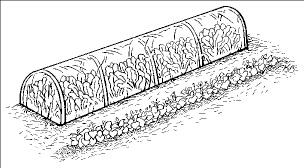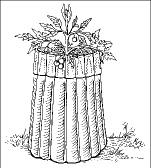Vegetable Gardening (135 page)

Drape Row Covers over Veggies
A
row cover
can be a clear plastic cover draped over half-circle wire hoops to create a tunnel effect (see Figure 21-3), or it can be the new lightweight cheesecloth-like fabric that's so light it floats on top of your vegetables. Both plastic and floating row covers protect plants from light freezes; however, if you expect really chilly temperatures (around 20 degrees), use another protection device, such as a cloche.
 Clear plastic heats up your crops faster and warmer than floating row cover material, but it needs venting to keep the plants from overheating. Floating row covers let in air, light, and water and don't overheat as easily as clear plastic row covers. You also can use both materials to protect your plants from insects.
Clear plastic heats up your crops faster and warmer than floating row cover material, but it needs venting to keep the plants from overheating. Floating row covers let in air, light, and water and don't overheat as easily as clear plastic row covers. You also can use both materials to protect your plants from insects.
Figure 21-3:
A clear plastic grow tunnel.
Place Wall O' Waters around Plants
Wall O' Waters
(see Figure 21-4) are double-walled, clear-plastic cylinders that hold narrow columns of water around your favorite vegetables. By placing Wall O' Waters around heat-loving plants, such as tomatoes, you can get a jump on spring. The water in the cylinders absorbs the warmth of the sun during the day and slowly releases the stored heat at night to protect your plants in cold temperatures. Even if the water freezes, it releases enough heat to protect your plants. Wall O' Waters have been reported to protect tomatoes in temperatures as low as 16 degrees.
Figure 21-4:
This Wall O' Water surrounds a tomato plant.
 To prevent overheating during the day, leave the tops open. For added protection at night, collapse the tops of these devices into a pyramid shape. Of course, after a plant has grown for a few weeks, it will outgrow the plastic cylinder, so you'll have to remove the Wall O' Water. But what a jump on the growing season you'll have by then!
To prevent overheating during the day, leave the tops open. For added protection at night, collapse the tops of these devices into a pyramid shape. Of course, after a plant has grown for a few weeks, it will outgrow the plastic cylinder, so you'll have to remove the Wall O' Water. But what a jump on the growing season you'll have by then!
Try Portable Greenhouses and Hoop Houses
If you really want to extend the growing season, stop fooling around with hot caps and blankets and buy a portable greenhouse or hoop house. You can find many different free-standing portable greenhouses on the market that are great for getting an early jump on the growing season and extending it into the fall. Walk-through hoop houses also have become popular because of their low cost and ease of use. They have a metal shell with clear plastic pulled over it and doors on either side. They keep the air warmer than a cold frame, but they're not as warm as a conventional greenhouse. Greenhouses and hoop houses can range in price from $200 to $2,000, depending on the materials and size. In the appendix, I list a number of manufacturers and suppliers that can help you choose the right greenhouse or hoop house for your location.
Appendix: Planning Guidelines and Other Resources
This appendix is vegetables by the numbers. All the distances, depths, and yields for more than 40 vegetables are listed in the section "Guidelines for Planting," which includes a chart that provides a great way for you to sketch your garden before you plant. The section "Frost Dates and the Length of the Growing Season" tells you what you need to know to avoid freezing out your veggies and stunting your crop. I also provide a guide to the hardiness zones and include a list of suppliers of vegetable seeds and other materials to get you started. And if you need even more information, I include a listing of Master Gardener organizations and Web sites by state.
Guidelines for Planting
The best way to plan your garden is to start by deciding how much produce you want. For example, if you like lettuce, 25 heads will take approximately 25 feet of row. The recommended distances between rows in Table A-1 tell you how much space to leave between crops.
Use the information in Table A-1 as a general guideline. You may choose to vary the distance between rows, for example, depending on the method of planting or cultivating. You usually can hand-hoe weeds between rows adequately in 18- or 24-inch-wide pathways; rototilling is faster, but pathways should be 30 or 36 inches wide to do so. If you garden intensively, such as in raised beds, you can space plants closer than indicated in the chart.
The days to maturity and the yield figures are averages. Depending on weather, soil fertility, pests, and weed pressure, yield and maturities in your garden can vary greatly. Just remember, you can always find friends, relatives, and bunnies who'd love some fresh, homegrown produce.
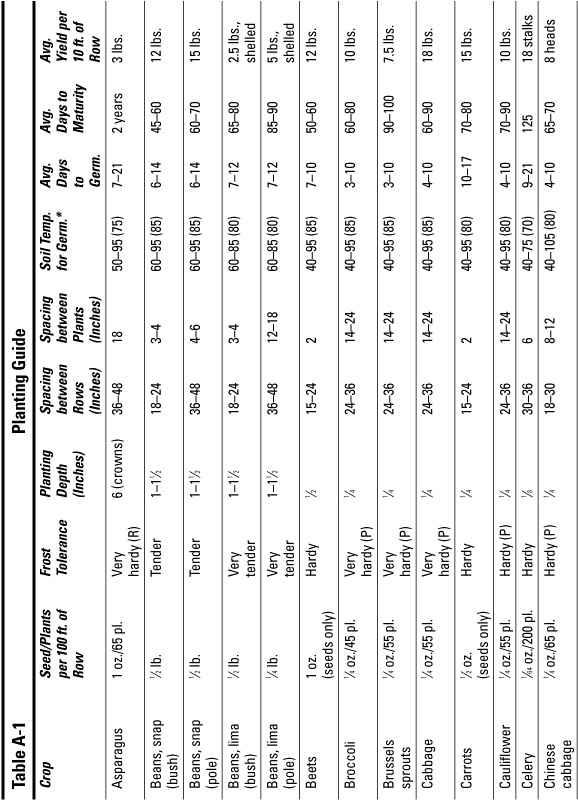
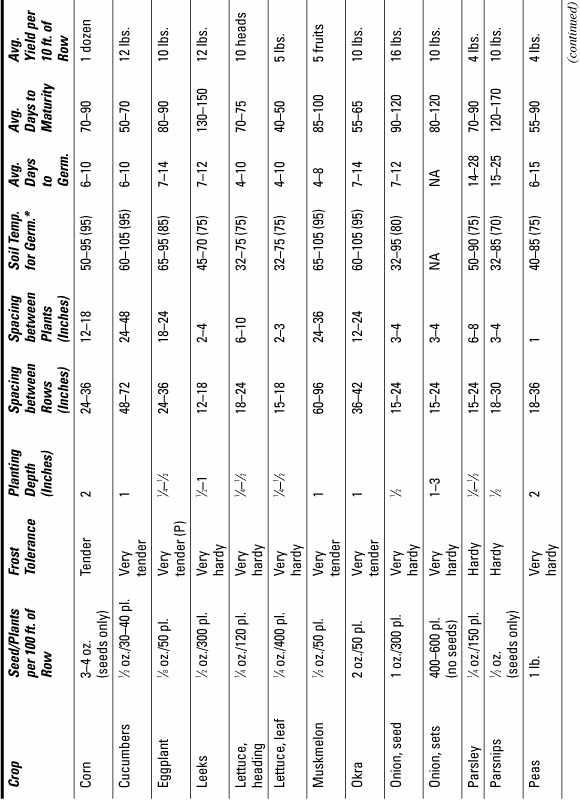
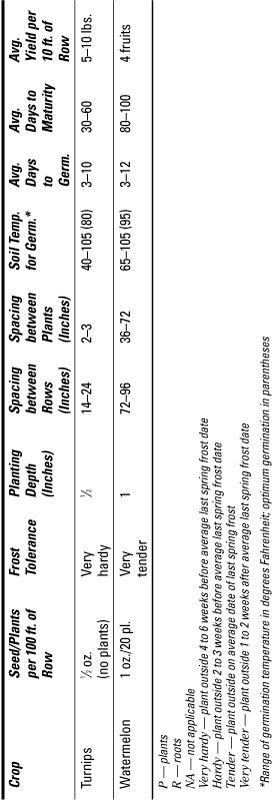
Frost Dates and the Length of the Growing Season
You can grow vegetables anywhere! Some of the largest, most beautiful vegetables I've ever seen are grown by avid gardeners in Alaska. If you can grow vegetables where the sun doesn't shine for 6 months of the year, you know that they must be easy to grow.
Table A-2 is a chart of the average annual first and last frost dates as well as the length of the frost-free growing season in 100 cities across the United States. Of course, this chart is only a guide, and your local climate will vary depending on many factors, including the variation in weather from year to year. Also, because of global warming, some gardeners are noticing longer growing seasons than in the past. So to get the most accurate dates, contact your local weather service or the Cooperative Extension Service office in your area. (To find your Extension Service office, check your state land grant university listings in the phone book.)
 Keep in mind that just because your frost-free growing season is only so many days, many vegetables that I list can tolerate a light frost. And you can extend your growing season by using special growing techniques (described in Chapter 21). However, warm-season vegetables, such as tomatoes, don't like even a touch of frost, so Table A-2 is much more accurate for estimating how many days you have to grow your favorite heat-loving vegetables.
Keep in mind that just because your frost-free growing season is only so many days, many vegetables that I list can tolerate a light frost. And you can extend your growing season by using special growing techniques (described in Chapter 21). However, warm-season vegetables, such as tomatoes, don't like even a touch of frost, so Table A-2 is much more accurate for estimating how many days you have to grow your favorite heat-loving vegetables.
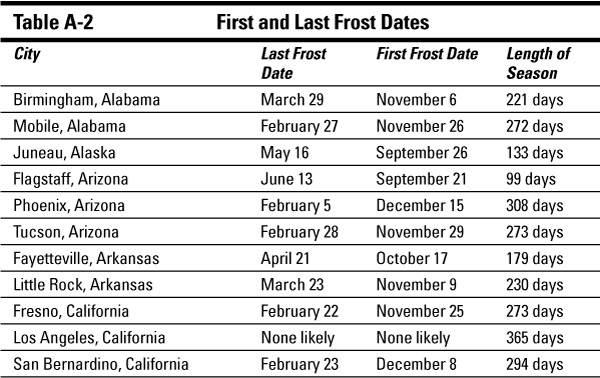
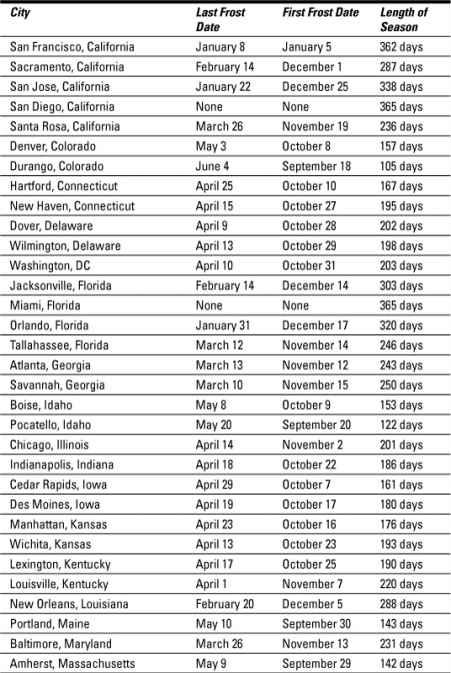
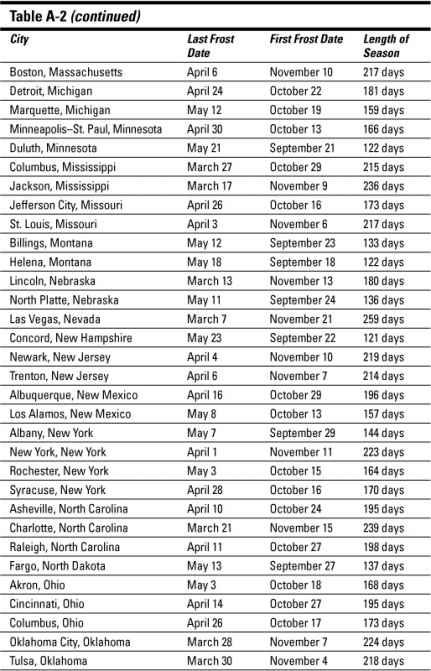
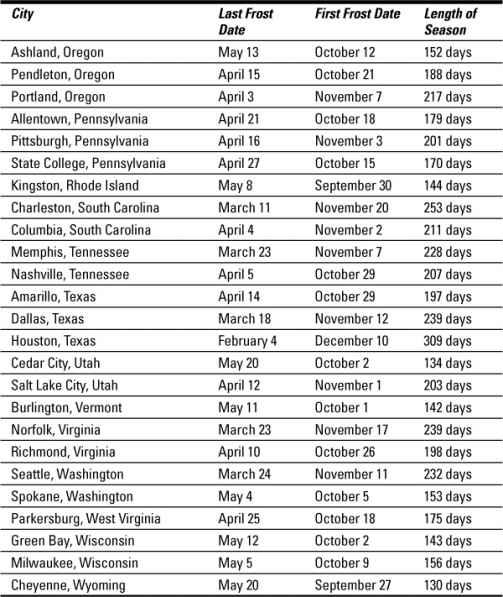
Hardiness Zones in North America
The U.S. Department of Agriculture has helpfully divided North America into plant hardiness zones based on average annual minimum temperatures; I refer to these hardiness zones throughout this book. Planting instructions regarding depth and timing may change depending on what zone you're in. Because of global warming, as with the length of the growing season (see the previous section), some gardeners find they now can grow less hardy plants in their area. Check with local Master Gardeners and garden centers to determine which plants are best for your area, and check out
www.garden.org/zipzone
to find out your own zone. (I list Master Gardener resources later in this appendix.)
 Your hardiness zone isn't as critical for vegetable growing as it is for growing fruits, perennial flowers, trees, and shrubs. However, knowing your hardiness zone is a good idea because in some warm areas, such as zones 7 and 8, you can grow two or three crops of the same vegetable in 1 year or even grow vegetables throughout the winter.
Your hardiness zone isn't as critical for vegetable growing as it is for growing fruits, perennial flowers, trees, and shrubs. However, knowing your hardiness zone is a good idea because in some warm areas, such as zones 7 and 8, you can grow two or three crops of the same vegetable in 1 year or even grow vegetables throughout the winter.
Where to Find Seeds and Other Resources
Vegetable seeds are available seemingly everywhere in the spring. From grocery stores to local garden centers, home centers, and hardware stores, everyone seems to sell seed packets. If you're interested in the standard vegetable varieties, these locations are great places to get them. However, if you're interested in some of the more unusual varieties that I mention in this book, try the catalog companies listed in the following sections. These companies mostly sell seeds within North America. Check other Web sites, such as
www.davesgarden.com
, for listings of vegetable seed suppliers in other parts of the world.
You may, however, want to avoid seed starting altogether and buy transplants. Local garden and home centers offer a broad selection of vegetable and fruit plants for sale in spring. Also, catalog companies now offer transplants through the mail. In the following sections, I indicate which companies currently offer transplants through their catalogs.
Finally, I include a list of fruit and berry nurseries for a broader selection and cheaper prices than what you may find locally as well as a list of tool and equipment suppliers for many of the products and devices I mention in this book. Part of the fun of gardening is shopping for new stuff, so check out these companies online. Or, if you like the armchair experience, write for a printed catalog. Some companies charge a small fee for their catalogs, but most are free.
